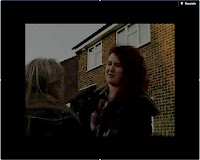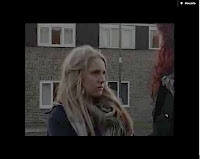What kind of media
institution might distribute your media product and why?
My media product is a short film and would be
distributed by a film distributor, and funded by a
production company.
A production company provides the funding
for works in the realms of the performing arts, new
media art, film,
television, radio, and video.
The production company may be directly
responsible for fundraising or may accomplish this through a parent company,
partner, or private investor. It handles budgeting, scheduling, scripting, the
supply with talent and resources, the organisation of staff, the production
itself, post-production, distribution, and marketing. Production companies are
often either owned or under contract with a media conglomerate, film studio or
entertainment company, who act as the production companies parent company (see
Time Warner, Viacom), together, this has become known as the "studio
system". They can also be mainstream independent (such as Lucasfilms) or
completely independent (such as Lionsgate). Production companies can also work
together in co-productions.
Being that, a production company is
only operational when a production is being produced and most of the talent and
crew are freelancers, many production companies are only required to hire
management staff that helps to oversee the companies daily activities. In some
cases, a production company can be run by only a handful of people. The
company's funds are mainly committed towards employing talent, crew, and
acquiring new updated production equipment on a regular basis. Many productions
often require at least one to two cameras and lighting equipment for on
location shooting. Production equipment is either leased or purchased from
another production company or directly from the manufacturer. In entertainment,
in order to secure experienced professional talent and crew, production
companies often become a signatory company to that talent or crew members
"guild". These signatory companies are required to sign an agreement
with that guild agreeing to follow the guild regulations. All big budget guild
productions are exclusive to guild members and non-guild members are not
allowed to participate in these productions unless authorised by the guild.
Productions with smaller budgets are allowed to use both guild talent and
talent from the public. The majority of the talent and crew working in the
entertainment industry are members of their professions guild. Most productions
in the entertainment industry are guild productions. A film distributor is a
company or individual responsible for releasing films to the public either
theatrically or for home viewing (DVD, Video-On-Demand, Download, Television
programs through broadcast syndication etc.). A distributor may do this
directly (if the distributor owns the theatres or film distribution networks)
or through theatrical exhibitors and other sub-distributors.
If a distributor is working with a
theatrical exhibitor, the distributor secures a written contract stipulating
the amount of the gross ticket sales to be paid to the distributor by the
exhibitor (usually a percentage of the gross) after first deducting a
"floor", which is called a "house allowance" (also known as
the "nut"), collects the amount due, audits the exhibitor's ticket
sales as necessary to ensure the gross reported by the exhibitor is accurate,
secures the distributor's share of these proceeds, and transmits the remainder
to the production company (or to any other intermediary, such as a film release
agent).
The distributor must also ensure
that enough film prints are struck to service all contracted exhibitors on the
contract-based opening day, ensure their physical delivery to the theatre by
the opening day, monitor exhibitors to make sure the film is in fact shown in
the particular theatre with the minimum number of seats and show times, and
ensure the prints' return to the distributor's office or other storage resource
also on the contract-based return date. In practical terms, this includes the
physical production of film prints and their shipping around the world (a
process that is beginning to be replaced by digital distribution) as well as
the creation of posters, newspaper and magazine advertisements, television
commercials, trailers, and other types of ads.
Furthermore, the distributor is
responsible for ensuring a full line of film advertising material is available
on each film which it believes will help the exhibitor attract the largest
possible audience, create such advertising if it is not provided by the
production company, and arrange for the physical delivery of the advertising
items selected by the exhibitor at intervals prior to the opening day.
If the distributor is handling an
imported or foreign film, it may also be responsible for securing dubbing or
subtitling for the film, and securing censorship or other legal or
organizational "approval" for the exhibition of the film in the
country/territory in which it does business, prior to approaching the
exhibitors for booking. Depending on which studio that is distributing the film,
the studio will either have offices around the world, by themselves or
partnered with another studio, to distribute films in other countries. If a
studio decides to partner with a native distributor, upon release both names
will appear. The foreign distributor may license the film for a certain amount
of time but the studio will ultimately retain the copyright of the film.
One way to fund a film would be to
receive a grant from the British Film Council, or the National Lottery. If not,
you can approach very wealthy businesses, for example: banks, or extremely
wealthy people. In the production of the film, Jamie Ebrada was the director
and chief editor, Josh Hitch was the cameraman, Mark Taylor was one of the
actors (also designing the title graphics of film).

























